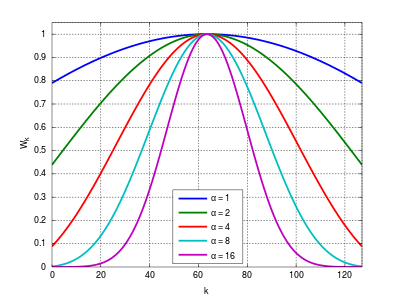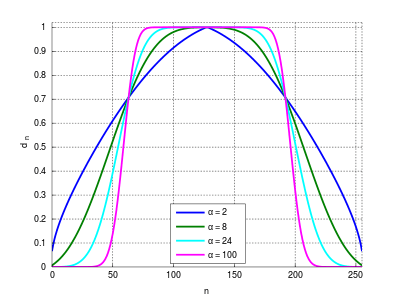Kaiser window

The Kaiser window, also known as the Kaiser–Bessel window, was developed by James Kaiser at Bell Laboratories. It is a one-parameter family of window functions used in finite impulse response filter design and spectral analysis[1]. The Kaiser window approximates the DPSS window which maximizes the energy concentration in the main lobe[2] but which is difficult to compute[3].
Definition
The Kaiser window is defined as[1]
where:
- I0 is the zeroth-order modified Bessel function of the first kind,
- τ is the window duration, and
- α is a non-negative real number that determines the shape of the window. In the frequency domain, it determines the trade-off between main-lobe width and side lobe level, which is a central decision in window design.
For digital signal processing, wa(t) can be sampled as
where N is the length of the window.
Fourier transform

The Fourier transform of wa(t) is[1]
where .
α controls the trade-off between main-lobe width and side-lobe area. As α increases, the main lobe of Wa(ω) increases in width, and the side lobes decrease in amplitude, as illustrated in the figure at right. α = 0 corresponds to a rectangular window. For large α, the shape of the Kaiser window (in both time and frequency domain) tends to a Gaussian curve.
Kaiser–Bessel-derived (KBD) window

A related window function is the Kaiser–Bessel-derived (KBD) window, which is designed to be suitable for use with the modified discrete cosine transform (MDCT). The KBD window function is defined in terms of the Kaiser window of length M+1, by the formula:
This defines a window of length 2M, where by construction dn satisfies the Princen-Bradley condition for the MDCT (using the fact that wM−n = wn): dn2 + dn + M2 = 1 (interpreting n and n + M modulo 2M). The KBD window is also symmetric in the proper manner for the MDCT: dn = d2M−1−n.
Applications
The KBD window is used in the Advanced Audio Coding digital audio format.
Notes
- 1 2 3 Kaiser, James F.; Schafer, Ronald W. (1980). "On the use of the I0-sinh window for spectrum analysis". IEEE Transactions on Acoustics, Speech, and Signal Processing. 28: 105–107. doi:10.1109/TASSP.1980.1163349.
- ↑ "Slepian or DPSS Window". ccrma.stanford.edu. Retrieved 2016-04-13.
- ↑ Oppenheim, A. V.; Schafer, R. W. (2009). Discrete-time signal processing. Upper Saddle River, N.J.: Prentice Hall. p. 541. ISBN 9780131988422.
References
- Kaiser, J. F. (1966). Digital Filters. In Kuo, F. F. and Kaiser, J. F. (Eds.), System Analysis by Digital Computer, chap. 7. New York, Wiley.
- Craig Sapp, Kaiser-Bessel Derived Window Examples and C-language Implementation, Music 422 / EE 367C: Perceptual Audio Coding (Stanford University course page, 2001).